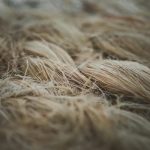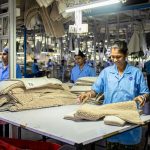When it comes to lyocell production, the spotlight is on N-methylmorpholine-N-oxide, or NMMO. This solvent plays a critical role in dissolving cellulose pulp, but you might wonder about its safety and environmental impact. While NMMO is deemed non-toxic and recyclable, there are still important safety measures to take into account in the manufacturing process. So, what makes NMMO a preferable choice, and how does it compare to other solvents in fiber production?
Table of Contents
Key Takeaways
- The primary chemical solvent used in lyocell production is N-methylmorpholine-N-oxide (NMMO).
- NMMO is a non-toxic solvent that efficiently dissolves cellulose pulp without producing harmful byproducts.
- The production process utilizes a closed-loop system, allowing for the recovery and recycling of NMMO, enhancing environmental sustainability.
- Despite being non-toxic, proper safety measures, including PPE and ventilation, are essential to protect workers from potential exposure.
- Overall, NMMO’s properties contribute to a safer manufacturing process compared to other fiber production solvents.
Overview of Lyocell Production Process
The production of Lyocell involves a streamlined process that transforms wood pulp into a sustainable fiber.
First, you start with sustainably sourced wood, which gets processed into cellulose pulp. This pulp is then dissolved in a non-toxic solvent, which allows the cellulose to be transformed into a viscous solution.
Sustainably sourced wood is processed into cellulose pulp and dissolved in a non-toxic solvent, creating a viscous solution.
After that, you extrude this solution through spinnerets, creating continuous filaments. These filaments are then solidified in a coagulation bath, where they regain their fiber form.
Once formed, you wash and dry the fibers to remove any residual solvent. Finally, you can spin the fibers into yarn, ready for textiles.
This entire process emphasizes sustainability, making Lyocell a popular choice for eco-conscious consumers.
Key Chemical Solvent: N-methylmorpholine-N-oxide (NMMO)
N-methylmorpholine-N-oxide (NMMO) plays an essential role in the production of Lyocell, serving as the primary solvent that dissolves cellulose pulp.
This powerful solvent enables the transformation of raw materials into a fiber that’s both durable and biodegradable.
When you work with NMMO, you’ll appreciate its ability to efficiently dissolve cellulose without toxic byproducts, making the process more sustainable compared to other solvents.
It’s also significant that NMMO is water-soluble, which aids in its recovery and recycling during production.
This means you’re not just getting a high-quality fiber; you’re also contributing to a more eco-friendly textile industry.
Environmental Impact of Lyocell Solvents
When examining the environmental impact of solvents used in Lyocell production, it’s crucial to evaluate both their sustainability and the waste management processes involved.
N-methylmorpholine-N-oxide (NMMO), the primary solvent, is biodegradable and can be recovered and reused in a closed-loop system, minimizing waste. This recycling process considerably reduces harmful emissions and conserves resources.
However, you should consider the energy consumption and potential pollution associated with the production of NMMO itself. Additionally, while the process is less toxic compared to other solvents, any improper handling or disposal could still pose risks to local ecosystems.
Safety Considerations for Workers
When working with lyocell solvents, it’s essential to understand their non-toxic properties and how they impact your safety.
You need to be aware of potential exposure risks and take steps to minimize them.
Creating a safe manufacturing environment not only protects you but also enhances overall productivity.
Non-Toxic Solvent Properties
Although many solvents used in industrial processes can pose significant health risks, the non-toxic solvents employed in the production of Lyocell offer a safer alternative for workers. These solvents are designed to minimize exposure and reduce potential harm, creating a healthier work environment.
Here’s a quick comparison of the properties of non-toxic solvents used in Lyocell:
| Properties | Non-Toxic Solvents |
|---|---|
| Health Risks | Minimal |
| Environmental Impact | Low |
| Worker Exposure | Reduced |
Worker Exposure Risks
While the non-toxic solvents in Lyocell production markedly reduce health risks, it’s still vital to take into account the potential for worker exposure.
Even with safer solvents, workers can face risks during manufacturing processes. Here are some key considerations for maintaining safety:
- Personal Protective Equipment (PPE): Always wear appropriate PPE, including gloves, goggles, and masks, to minimize direct contact with solvents.
- Ventilation: Guarantee proper ventilation in the workplace to reduce inhalation risks and maintain air quality.
- Training: Participate in safety training programs that cover handling solvents and emergency procedures to stay informed and prepared.
Safe Manufacturing Environment
Creating a safe manufacturing environment is essential for protecting workers in the Lyocell production process. You should guarantee that proper ventilation systems are in place to reduce exposure to harmful solvents. Regular monitoring of air quality can help identify potential risks early.
It’s critical to provide personal protective equipment (PPE) like gloves and masks to safeguard against chemical exposure. Training workers on safe handling procedures and emergency protocols is imperative for minimizing accidents.
Encourage open communication about safety concerns and foster a culture where everyone feels responsible for maintaining safety standards. By prioritizing these practices, you not only protect your workers but also enhance overall productivity and job satisfaction in the workplace.
Comparison With Other Fiber Production Processes
When you compare the lyocell process to the viscose process, you’ll notice key differences in methods and sustainability.
The environmental impact of these fiber production processes can vary greatly, influencing your choices as a consumer.
Understanding these comparisons helps you appreciate the benefits of lyocell’s production.
Viscose Process Comparison
The viscose process stands out among fiber production methods due to its reliance on a solvent-based system to dissolve cellulose, which is extracted from wood pulp.
Unlike cotton or wool, viscose offers unique characteristics, but it also involves significant processing. Here’s how it compares to other fiber production methods:
- Cotton Production: Cotton fibers grow naturally and require minimal processing, making them less resource-intensive than viscose.
- Polyester Production: Polyester, a synthetic fiber, relies on petroleum-based resources and may have a larger environmental footprint than viscose.
- Lyocell Process: While lyocell also uses a solvent, it employs a closed-loop system that recycles solvents, making it more eco-friendly compared to viscose.
This comparison highlights the varying sustainability and processing demands across fiber production methods.
Environmental Impact Analysis
Although many fiber production processes impact the environment, lyocell stands out due to its eco-friendly attributes. The closed-loop process recycles 99% of the solvents used, greatly reducing waste. In contrast, traditional methods like cotton and polyester production often lead to substantial pollution and resource depletion.
Here’s a comparison of environmental impacts:
| Fiber Type | Water Usage | Chemical Use | Waste Produced | Carbon Footprint |
|---|---|---|---|---|
| Lyocell | Low | Low | Minimal | Low |
| Cotton | High | High | High | Medium |
| Polyester | Medium | Medium | Medium | High |
| Viscose | Medium | High | High | Medium |
Benefits of Using Non-Toxic Solvents
Choosing non-toxic solvents in the production of lyocell not only enhances environmental sustainability but also protects the health of workers and consumers.
By opting for safer alternatives, you can enjoy several key benefits:
- Reduced Health Risks: Non-toxic solvents lower the chances of harmful exposure for factory workers and end-users, promoting a safer environment.
- Minimized Environmental Impact: These solvents break down more easily in nature, reducing pollution and supporting biodiversity.
- Improved Product Quality: Non-toxic solvents can enhance the overall quality of lyocell fibers, resulting in softer, more durable fabrics.
Advantages of Lyocell Fibers in the Market
Lyocell fibers stand out in the textile market due to their unique combination of sustainability and performance. You’ll appreciate their eco-friendly nature, as they’re derived from sustainably sourced wood pulp and produced in a closed-loop process, minimizing waste and chemical usage.
These fibers offer excellent moisture-wicking properties, keeping you cool and comfortable in various conditions. Plus, they’re naturally breathable and hypoallergenic, making them ideal for sensitive skin.
When it comes to durability, Lyocell fibers resist wrinkles, ensuring your garments look fresh and stylish longer. You’ll also love their soft, silky feel, which adds a luxurious touch to your wardrobe.
Frequently Asked Questions
How Does NMMO Compare to Other Solvents Used in Textile Production?
When you compare NMMO to other solvents in textile production, you’ll find it’s more environmentally friendly, with lower toxicity levels. Its efficiency in dissolving cellulose sets it apart, making it a preferred choice for sustainable practices.
What Measures Are in Place to Ensure Solvent Recycling Efficiency?
You might wonder how solvent recycling efficiency is guaranteed. Advanced filtration systems, closed-loop processes, and continuous monitoring work together to minimize waste. These measures not only enhance sustainability but also boost the overall effectiveness of production.
Are There Any Long-Term Effects of Using Lyocell Fabrics?
You might notice that lyocell fabrics are generally safe for long-term use. They’re breathable and biodegradable, but individual reactions can vary. It’s always smart to monitor your skin’s response to any fabric over time.
How Does Lyocell Production Impact Local Ecosystems?
Think of lyocell production as a double-edged sword; while it creates sustainable fabrics, it can disrupt local ecosystems. You’ll notice changes in water quality and wildlife habitats, highlighting the need for responsible practices in manufacturing.
What Certifications or Standards Does Lyocell Production Meet for Safety?
Lyocell production meets several certifications, like OEKO-TEX and FSC. These standards guarantee the fabric’s safety and environmental responsibility. You can trust that lyocell is produced with minimal impact on health and ecosystems.
- Recycling Nonwoven Fabrics: Is It Possible? - July 11, 2025
- Recycling Nonwoven Fabrics: Is It Possible? - July 11, 2025
- Recycling Nonwoven Fabrics: Is It Possible? - July 11, 2025







